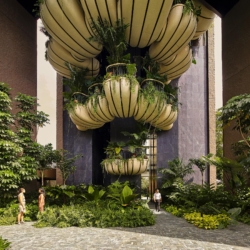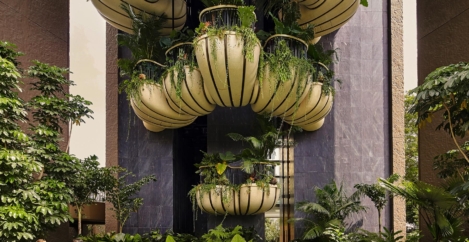September 28, 2020
Nature positive cities have potential to transform the world
 COVID-19 recovery packages that include infrastructure development will influence the relationship between cities, humans and nature for the next 30 to 50 years. With the built environment home to half the world’s population and making up 40 percent of global GDP, cities are an engine of global growth and crucial to the economic recovery.
COVID-19 recovery packages that include infrastructure development will influence the relationship between cities, humans and nature for the next 30 to 50 years. With the built environment home to half the world’s population and making up 40 percent of global GDP, cities are an engine of global growth and crucial to the economic recovery.
Research shows that nature-positive solutions can help cities rebuild in a healthier and more resilient way while creating opportunities for social and economic development. The World Economic Forum’s new Future of Nature and Business Report found that following a nature-positive pathway in the urban environment can create $3 trillion in business opportunity and 117 million jobs.
Cities are responsible for 75 percent of global GHG emissions and are a leading cause of land, water and air pollution, which affect human health. Many cities are also poorly planned, lowering national GDP by as much as 5 percent due to negative impacts such as time loss, wasted fuel and air pollution. However, practical solutions exist that can make living spaces better for economic, human and planetary health.
[perfectpullquote align=”right” bordertop=”false” cite=”” link=”” color=”” class=”” size=””]There are many examples of nature-based solutions that can benefit people and planet[/perfectpullquote]
“Business as usual is no longer sustainable,” said Akanksha Khatri, Head of the Nature Action Agenda at the World Economic Forum. “Biodiversity loss and the broader challenges arising from rapid urban population growth, financing gaps and climate change are signalling that how we build back can be better. The good news is, there are many examples of nature-based solutions that can benefit people and planet.”
Global examples
The study, in collaboration with AlphaBeta, highlighted examples of projects deploying nature-positive solutions and the business opportunities they create.
- Cape Town: Cape Town was just 90 days away from turning off its water taps. Natural infrastructure solutions (i.e. restoring the city’s watersheds) were found to generate annual water gains of 50 billion litres a year, equivalent to 18 percent of the city’s supply needs at 10 percent of the cost of alternative supply options, including desalination, groundwater exploration and water reuse
- Singapore: Singapore’s water leakage rate of 5 percent is significantly lower than that of many other major cities thanks to sensors installed in potable water supply lines. Globally, reducing municipal water leakage could save $115 billion by 2030. Returns on investment in water efficiency can be above 20 percent.
- Suzhou: Suzhou Industrial Park’s green development in China has seen its GDP increase 260-fold, partially through green development. The park accommodates 25,000 companies, of which 92 are Fortune 500 companies, and is home to 800,000 people. The park has 122 green-development policies, including stipulations on optimizing and intensifying land use, improvement of water and ecological protection, and the construction of green buildings. As a result, 94 percent of industrial water is reused, 100 percent of new construction is green, energy is dominantly renewable and green spaces cover 45 percent of the city.
- San Francisco: San Francisco requires new buildings to have green roofs. The “green” roof market is expected to be worth $9 billion in 2020 and could grow at around 12 percent annually through 2030, creating an incremental annual opportunity of $15 billion.
- Philippines: The loss of coastal habitats, particularly biodiverse and carbon-rich mangrove forests, has significantly increased the risk from floods and hurricanes for 300 million people living within coastal flood zones. A pilot project in the Philippines, one of the countries most vulnerable to climate change, is monetizing the value of mangroves through the creation of the Restoration Insurance Service Company (RISCO). RISCO selects sites where mangroves provide high flood reduction benefits and models that value. Insurance companies will pay an annual fee for these services, while organizations seeking to meet voluntary or regulatory climate mitigation targets will pay for blue carbon credits. Overall, restoring and protecting mangrove forests in human settlements can reduce annual flood damage to global coastal assets by over $82 billion while significantly contributing to fighting climate change.
The report identifies five complementary transitions to create nature-positive built environments and outlines the business opportunities and potential cost savings for programmes targeting urban utilities for water, electricity and waste, land planning and management, sustainable transport infrastructure and the design of buildings.
Underused office space
Global examples call out areas to be improved. For example, an estimated 40 billion square metres of floor space is not used at full occupancy during office hours – an area roughly equivalent to the size of Switzerland. The COVID-19 upheaval has prompted a surge in flexible and remote working models in many countries – greater application of such models could help reduce the need for private office space in the future.
The report calls for both government officials and businesses to play their part in raising and steering finance for sustainable urban infrastructure. “Regulations in areas including urban master planning, zoning and mandatory building codes will be critical to unlocking the potential of net-zero, nature-positive cities and infrastructure,” said Khatri. “We are at a critical juncture for the future of humanity. Now is the time to treat the ecological emergency as just that. A net-zero, nature-positive path is the only option for our economic and planetary survival and how we choose to use COVID-19 recovery packages might be one of our last chances to get this right.”
Image: Heatherwick Studio’s Eden Tower in Singapore.














